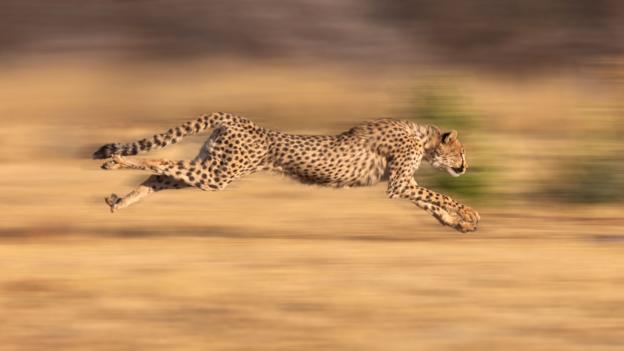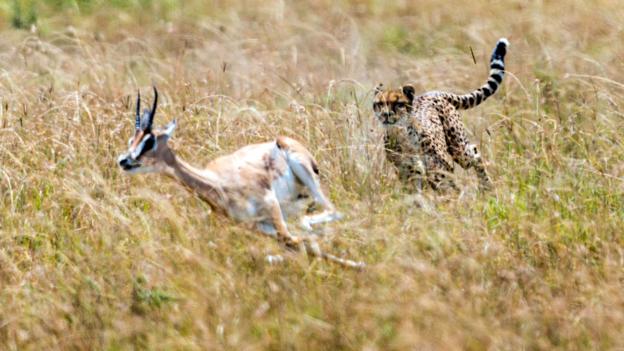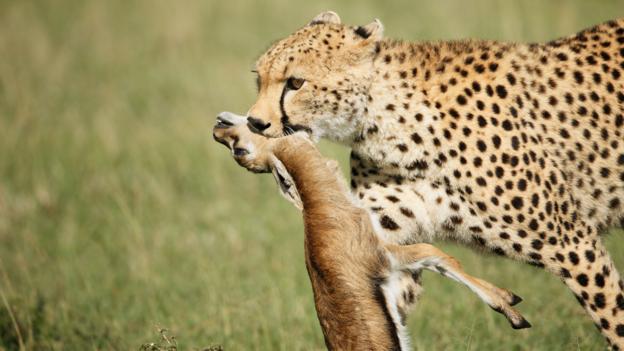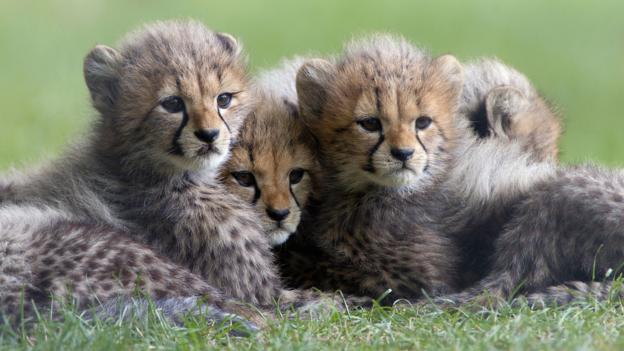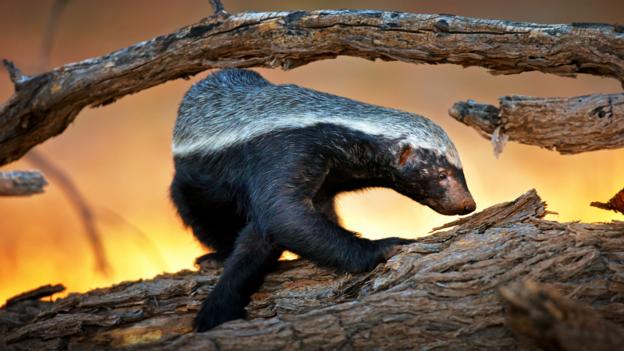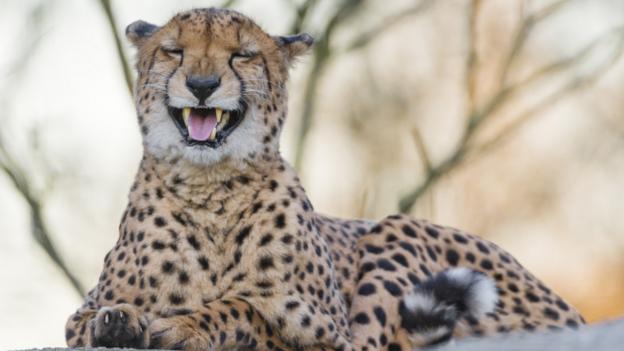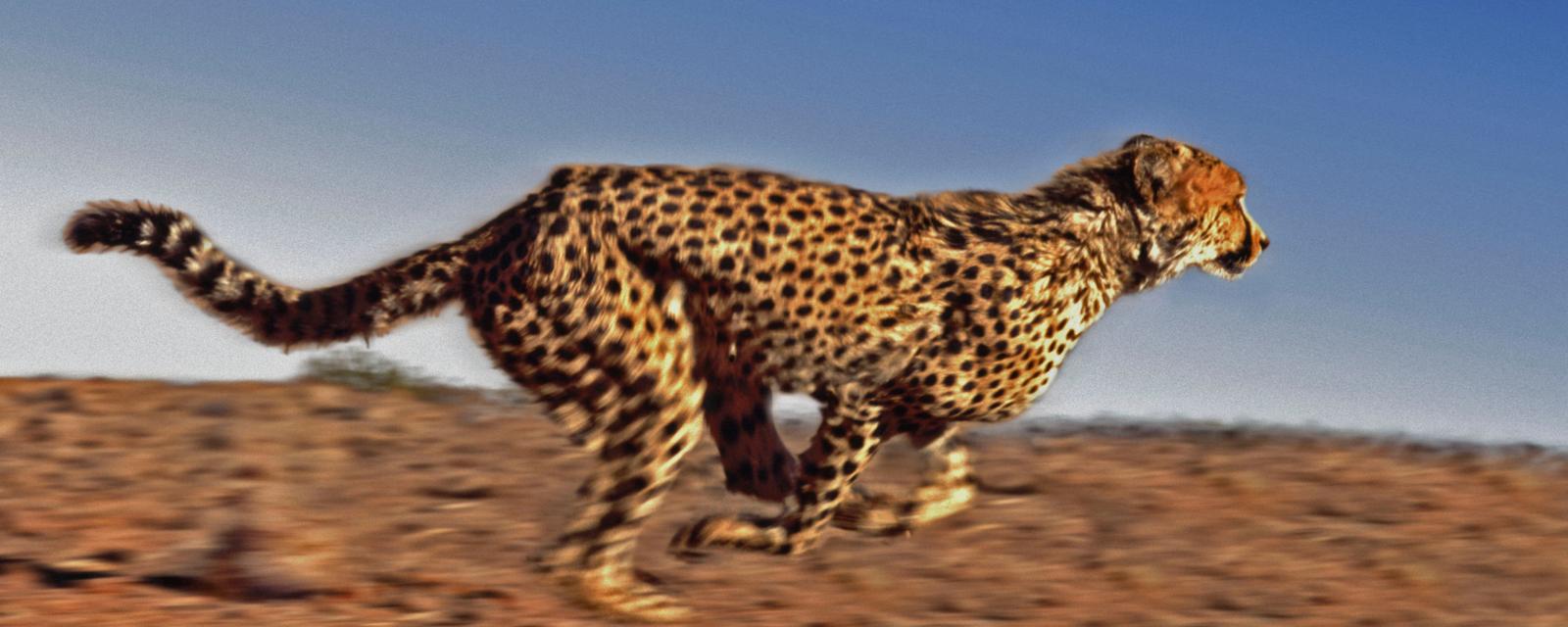
Cheetahs are the world's fastest land mammal, but there's much more to them than speed
Reputation: Cheetahs are fast, super-evolved
predators capable of running at really impressive speed. But they are
wimps when it comes to defending a kill, relinquishing too easily to
bigger, better predators like lions and hyenas. They also lose a lot of
cubs to predators. In fact, they are so specialized, they deserve to go
extinct.
Reality: Cheetahs are fast, for sure, but exactly how fast is hotly disputed. Just as important as speed is agility. Speed and agility help explain why the cheetah is one of the most successful hunters of any carnivore. They do lose a lot of cubs to predation, but they do not deserve to go extinct.
It is one of the first things a child learns about the natural world: cheetahs are fast. An eager parent might even feed a budding prodigy some context, like the fact that the cheetah is the fastest living land mammal. There might even be a temptation to put a figure on that speed. But here, it would be sensible to proceed with caution.
I have nothing against Sarah or Cincinnati Zoo but a little digging has turned up a reliable and rather quaint account of an even faster cheetah. The short communication appeared in the Journal of Zoology in 1997, but recounts events that took place in more than 30 years earlier in 1965.
The cheetah in question had been orphaned and reared by conservationist David Hopcraft on his farm in Kenya. When she was old enough, Hopcraft released her back to the wild but from time to time she would drop by, as if paying her old friend a visit.
On one of these reunions, "between 10:00h and 11.30h, on firm level ground with a slight covering of murram dust", Hopcraft got this cheetah to run repeatedly over a 201.2m course measured using a surveyor's tape, with a "taut length of white wool" tied between two posts at the start. In attendance that day was an athletics coach "well used to hand-timing" and armed with "an analogue stopwatch". By trailing a hunk of meat from the back of a Land Rover, Hopcraft induced the cheetah to complete the course three times. Her average speed was 28.7m/s.
This is much faster than Sarah's average of 16.8m/s because Sarah was timed from a standing start and Hopcraft's cheetah wasn't. But the Kenyan cheetah's average is still faster than Sarah's top speed. This is 98 kilometres per hour or, if you prefer imperial measures, 61 miles per hour. Fast.
But speed isn't everything. If a cheetah is to hunt successfully, it must stick to the tail of its prey, which requires incredible maneuverability. A couple of years ago scientists fitted some wild cheetahs with nifty GPS collars capable of recording the animal's hunting dynamics in unprecedented detail. This revealed extraordinary acceleration and deceleration, and some incredibly tight twists and turns.
If a cheetah needs to make an especially tight turn (often as it homes in on its prey), it will decelerate rapidly. Think superbikes on a bend. As the cheetah begins to bank, its ridged footpads and non-retractable claws help to prevent it from skidding, rather like the treads on a tyre.
"If all you could do was run fast in a straight line you wouldn't get very far if you're hunting gazelle," says Sarah Durant of the Zoological Society of London, who has studied cheetahs for more than 25 years.
In this time, Durant has revealed plenty of other truths about this fleet-footed cat. For a start, cheetahs have one of the most impressive kill stats of any carnivore. In 2012, she and her colleagues revealed that of 192 chases observed in the Serengeti over almost 20 years, 114 ended in a kill. That's a 58% success rate.
How do they pull this off? For a start, they mainly hunt during the day, when lions and hyenas are having a kip. Even then, they choose their moments carefully. When Durant played the sound of a lion roaring or hyena whooping, cheetahs instantly became wary and often moved away from the speaker – especially if they had heard a lion. They also became much less likely to hunt. "Their hunting activity goes down to virtually zero if they think there's another predator around," says Durant.
When cheetahs do hunt, there is still a lot they can do to avoid being robbed. After 65% of kills, they drag their prize to a more secluded, shadier spot, a precaution that prevents circling vultures from attracting unwanted attention. On average, a cheetah will move its dead prey around 60m before it takes a bite. But one individual moved its kill more than 700m. "They are very good at their risk management," concludes Durant.
Whilst cheetahs seem to be able to handle the competition with bigger predators over food, they don't do so well at protecting their own offspring, particularly in open habitats like the Serengeti. There, it's estimated that only around one in five cheetah cubs survive to adolescence at 14 months. Most of the others are killed by predators, mainly lions.
The dismal survival of cheetah cubs poses a direct challenge to one of the more outlandish popular myths about cheetahs: that cheetah cubs resemble vicious honey badgers in an effort to look more fierce than they are.
When I first heard this, from my then six-year-old son, I told him (politely) he was talking cobblers. But he was so insistent, I plugged "cheetah cub" and "honey badger" into a search engine and what did I find? Photographs of cute, fluffy, white-backed cheetah cubs alongside what, at a glance or at a distance, might be mistaken for the notoriously ferocious honey badger or ratel.
Of course, natural selection has created this kind of defensive mimicry over and over. But until someone gets permission to paint spots on the backs of baby cheetahs - which frankly seems unlikely - I am not prepared to add this to the list of truths about cheetahs.
Durant is keen to correct one popular perception about cheetahs in particular. "You hear quite a lot that they are evolved to the point of extinction," she says. If you are someone who idly spouts nonsense like this, please stop now: it isn't remotely true.
Reality: Cheetahs are fast, for sure, but exactly how fast is hotly disputed. Just as important as speed is agility. Speed and agility help explain why the cheetah is one of the most successful hunters of any carnivore. They do lose a lot of cubs to predation, but they do not deserve to go extinct.
It is one of the first things a child learns about the natural world: cheetahs are fast. An eager parent might even feed a budding prodigy some context, like the fact that the cheetah is the fastest living land mammal. There might even be a temptation to put a figure on that speed. But here, it would be sensible to proceed with caution.
From time to time the cheetah would drop byJust days before Jamaican sprinter Usain Bolt won the 100-metre race at the 2012 Olympics in London, Sarah (a very fast cheetah at Cincinnati Zoo) ran the same distance far faster: in a cool 5.95 seconds compared to Bolt’s lazy Olympian 9.63s. Her average speed over the distance was 16.8 metres per second and she reached a top speed of 27.3m/s. This, Cincinnati Zoo claimed, was a "new world speed record".
I have nothing against Sarah or Cincinnati Zoo but a little digging has turned up a reliable and rather quaint account of an even faster cheetah. The short communication appeared in the Journal of Zoology in 1997, but recounts events that took place in more than 30 years earlier in 1965.
The cheetah in question had been orphaned and reared by conservationist David Hopcraft on his farm in Kenya. When she was old enough, Hopcraft released her back to the wild but from time to time she would drop by, as if paying her old friend a visit.
On one of these reunions, "between 10:00h and 11.30h, on firm level ground with a slight covering of murram dust", Hopcraft got this cheetah to run repeatedly over a 201.2m course measured using a surveyor's tape, with a "taut length of white wool" tied between two posts at the start. In attendance that day was an athletics coach "well used to hand-timing" and armed with "an analogue stopwatch". By trailing a hunk of meat from the back of a Land Rover, Hopcraft induced the cheetah to complete the course three times. Her average speed was 28.7m/s.
This is much faster than Sarah's average of 16.8m/s because Sarah was timed from a standing start and Hopcraft's cheetah wasn't. But the Kenyan cheetah's average is still faster than Sarah's top speed. This is 98 kilometres per hour or, if you prefer imperial measures, 61 miles per hour. Fast.
But speed isn't everything. If a cheetah is to hunt successfully, it must stick to the tail of its prey, which requires incredible maneuverability. A couple of years ago scientists fitted some wild cheetahs with nifty GPS collars capable of recording the animal's hunting dynamics in unprecedented detail. This revealed extraordinary acceleration and deceleration, and some incredibly tight twists and turns.
If all you could do was run fast in a straight line you wouldn't get very far if you're hunting gazelleThe cheetah boasts several adaptations that help it perform such movements without losing its feet. A wild cheetah weighs around 50 kilograms and about half of this mass is devoted to its locomotor muscles. It has relatively thick bones, crucial to cope with the extreme forces experienced during high-speed maneuvers.
If a cheetah needs to make an especially tight turn (often as it homes in on its prey), it will decelerate rapidly. Think superbikes on a bend. As the cheetah begins to bank, its ridged footpads and non-retractable claws help to prevent it from skidding, rather like the treads on a tyre.
"If all you could do was run fast in a straight line you wouldn't get very far if you're hunting gazelle," says Sarah Durant of the Zoological Society of London, who has studied cheetahs for more than 25 years.
In this time, Durant has revealed plenty of other truths about this fleet-footed cat. For a start, cheetahs have one of the most impressive kill stats of any carnivore. In 2012, she and her colleagues revealed that of 192 chases observed in the Serengeti over almost 20 years, 114 ended in a kill. That's a 58% success rate.
Their hunting activity goes down to virtually zero if they think there's another predator aroundBut isn't it true that cheetahs lose a lot of these kills to bigger, better predators? No, it simply isn't. It is true that a cheetah will only rarely stand up to competitors like hyenas or lions, but Durant and her colleagues have shown that cheetahs only abandon around 10% of their kills to these heavyweights.
How do they pull this off? For a start, they mainly hunt during the day, when lions and hyenas are having a kip. Even then, they choose their moments carefully. When Durant played the sound of a lion roaring or hyena whooping, cheetahs instantly became wary and often moved away from the speaker – especially if they had heard a lion. They also became much less likely to hunt. "Their hunting activity goes down to virtually zero if they think there's another predator around," says Durant.
When cheetahs do hunt, there is still a lot they can do to avoid being robbed. After 65% of kills, they drag their prize to a more secluded, shadier spot, a precaution that prevents circling vultures from attracting unwanted attention. On average, a cheetah will move its dead prey around 60m before it takes a bite. But one individual moved its kill more than 700m. "They are very good at their risk management," concludes Durant.
Whilst cheetahs seem to be able to handle the competition with bigger predators over food, they don't do so well at protecting their own offspring, particularly in open habitats like the Serengeti. There, it's estimated that only around one in five cheetah cubs survive to adolescence at 14 months. Most of the others are killed by predators, mainly lions.
The dismal survival of cheetah cubs poses a direct challenge to one of the more outlandish popular myths about cheetahs: that cheetah cubs resemble vicious honey badgers in an effort to look more fierce than they are.
When I first heard this, from my then six-year-old son, I told him (politely) he was talking cobblers. But he was so insistent, I plugged "cheetah cub" and "honey badger" into a search engine and what did I find? Photographs of cute, fluffy, white-backed cheetah cubs alongside what, at a glance or at a distance, might be mistaken for the notoriously ferocious honey badger or ratel.
Of course, natural selection has created this kind of defensive mimicry over and over. But until someone gets permission to paint spots on the backs of baby cheetahs - which frankly seems unlikely - I am not prepared to add this to the list of truths about cheetahs.
Durant is keen to correct one popular perception about cheetahs in particular. "You hear quite a lot that they are evolved to the point of extinction," she says. If you are someone who idly spouts nonsense like this, please stop now: it isn't remotely true.
